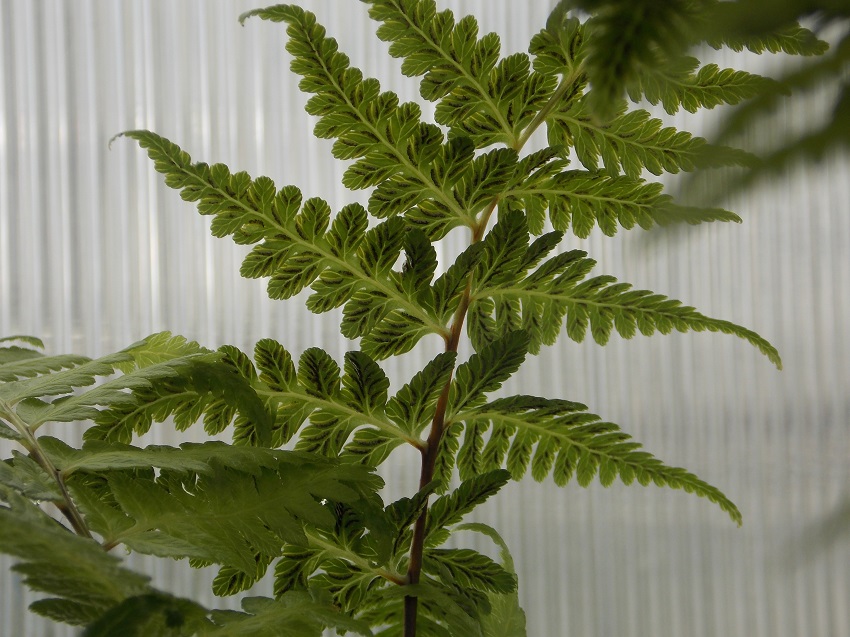Local Fern On Global Threatened Species List
The International Union for the Conservation of Nature [IUCN] released their latest Red List of Threatened Species on June 10th; including two new entries from Bermuda – the Governor Laffan’s Fern and Bermuda Shield Fern. The IUCN Red List of Threatened Species is seen as the global standard for assessing the extinction risk faced by the world’s endangered species.
“A Red List assessment takes into account a number of scientifically rigorous criteria which are used to establish the conservation status of a species,” explained the Biodiversity Officer at the Department of Conservation Services, Alison Copeland.
“A number of Bermudian species, such as the Skink and Cahow already appear on the Red List, but most of Bermuda’s endemic plants have never been assessed.”
The Red List assessments for Bermuda’s endemic plants are being compiled by the Department of Conservation Services in collaboration with the UK Overseas Territories Programme from the Royal Botanic Gardens Kew, as part of an effort to Red List endemic plants which occur in the Overseas Territories.
In total nine Bermudian species will undergo Red List assessments over the next year. In addition to the Governor Laffan’s Fern and Bermuda Shield Fern which have been completed and appear on the new list; species that are still undergoing assessment are the Bermuda Peperomia, Bermuda Sedge, Darrell’s Fleabane and Bermuda Bean. Three endemic trees, the Bermuda Cedar, Olivewood and Bermuda Palmetto already appear on the Red List and will be re-assessed to update the existing listing.
These assessments involve considerable work in the field; mapping the locations of endemic plant populations, recording counts of mature individuals and juveniles, looking for signs of reproduction within the population, documenting threats and potential threats to each population and summarizing the habitat.
Red list assessments also involve library research on the historic distributions of these plants, the name changes many have undergone over the years, and gathering information on current and planned conservation activities.
Ms Copeland explained: “In order to be listed on the IUCN Red List, species must meet a list of strict criteria. We need to know as closely as possible how many mature individuals remain in the wild and if they are reproducing. We also need to know why the species has declined, what the threats to it are, and if those threats can be stopped.
“We enter all the variables into the Red List assessment and it weighs the positive and negative data and produces a conservation status. The options for status range from Extinct in the Wild, to Critically Endangered, Endangered, Vulnerable, Near Threatened or of Least Concern.
“ ‘Positives’ are things like conservation actions that are being taken, threats that are being reduced etc. ‘Negatives’ are things like known or suspect continuing decline, identified threats, and having too much of the total population in one place.”
During the preparation of these assessments, much new information was collected on the status of Bermuda’s endemic plants, the threats they face and the distribution of the remaining populations.
There are not a lot of species with an ‘Extinct in the Wild’ status on the IUCN Red List, and because of that special status, the Governor Laffan’s Fern is featured in IUCN’s global media release announcing the updated June Red List. The release can be found here.
Bermuda Shield Fern [IUCN listing link]
The Bermuda Shield Fern lives on damp rock faces and at the mouths of caves and rocky outcrops in mature woodland. It appears on the June 2014 Red List as ‘Endangered’.
This species is listed as endangered as there are so few individuals remaining, and it is only known to occur in three locations on the island. As it is an endemic species, these 3 locations are its global distribution. Also the quality of its habitat continues to decline because of invasive species and human activities.
Governor Laffan’s Fern [IUCN listing link]
The Governor Laffan’s Fern has been assessed as being ‘Extinct in the Wild’. This term is applied to species which are on the last step of the path to extinction. This fern was last seen growing wild in Bermuda in 1905, and repeated attempts to rediscover it over the last 100 years have failed. This species has survived to present day as a potted plant. It is hoped that Red Listing the species will attract interest and much needed funding for the recovery of this species.
For more information on the IUCN Red List visit here.
Read More About
Category: All, Environment




I actually remember seeing these all over as a kid, even having some in my yard. Not any more.
Didn’t even come to mind til I saw this article.
I can’t say as I’ve ever seen the Governor Laffan’s fern, but the other one? I need to think about because part of me wants to say that’s pretty common, but I could be confusing it with something else.
I work around the island every day on varying properties and I can tell you that this FERN IS NOT ENDANGERED! It is everywhere in tremendous quantities! I can say so, because the nature of my job has me in every random corner of this island, in woodland areas, caves, etc. This fern is everywhere. Just makes me shake my head. Where do these people get their facts?